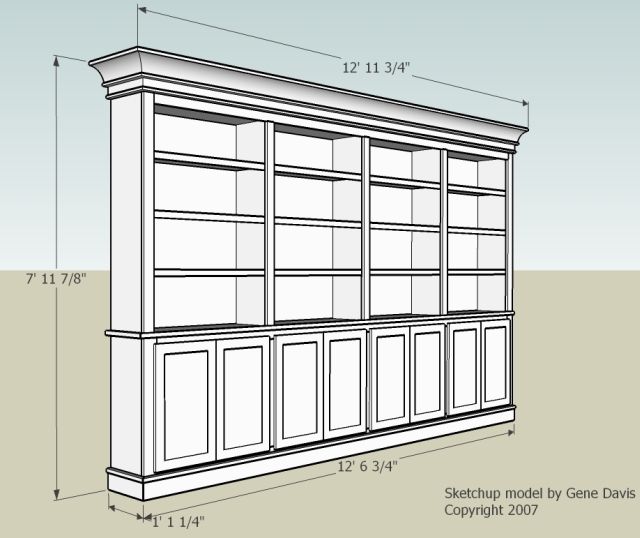Question
I don't really build bookcases regularly, but need to price a job that is pretty standard bookcases. Overall it will be 18' of cabinets using oak with crown and base. I live in California and was looking at about $2,500. Does that seem right?
Forum Responses
(Cabinetmaking Forum)
From contributor M:
Seems low to me. Not knowing the circumstances, it is hard to tell you how much to charge. I am in Ontario, Canada and would typically get about $5400 for this in oak veneer particle, solid wood edging, and a stain and lacquer finish. Start adding doors and such and the price goes up proportionally.

I don't care who it is. Work is work. Personally I wouldn't work for my neighbor, but if I had to, I would charge more because I know inevitably I am going to be asked to do some touchup or tweaking down the road. Charity is for your personal life, not business. Just because you have materials lying around doesn't mean they are free. You paid for them at one point, right?
Material costs + waste + profits
Overhead + salary + benefits + profits
Don't forget to bill for design time, cut listing, optimization, ordering and unloading materials, fabrication, packaging, shipping, installation, all the behind the scenes time doing day to day business operations.
Rent/mortgage, liability insurance, workman's comp, electric, heat/ac, dumpster, phone/fax/cell/internet, investment in tooling and machinery and depreciation associated with these investments, vehicle costs, accounting, health insurance, retirement plan, etc.
Profits are what you make for investing money, time and risk into being self-employed. Profits are not your salary.
My pricing starts at $1,000 a foot installed for Euro cases with primer and 5 piece raised panel. Your material costs alone will be close to your current estimate. I wouldn't deliver the unprocessed sheet goods, solid woods, and pails of finish for that price. Glue, screws, staples, sandpaper, rags? The list goes on and on.
To preface a comment with "what I do" is legitimate. To tell someone "what you must do" may not be. Judge not lest ye be judged...
One great way to learn pricing is to get someone (maybe on WOODWEB) whose work you respect and who is in the same or similar market and to pay him a couple of hundred dollars for doing a takeoff of your drawing/sketch. Do this a few times, and keep close track of your costs - especially the hidden ones (a fairly comprehensive list of them was started here in this thread) and then do what too many don't - review that list and see what actually happened. Do this a few times and you will have a better handle on what your pricing needs to be.
But this is still your job and your livelihood and you cannot work for free, and by the sound of your initial quote, you're not making anything on this job. It's one thing to lend a neighbor a tool or help them with a small project, but you can't spend a week or two working and not get paid. At least that's my opinion and I'm sticking to it.
Yes, there are operational cost differences all around the country to consider, but materials cost the same, and electric, gas, tooling, machinery are all things that don't change regionally. It is really easy to underestimate the amount of cumulative time it takes to get things done. I used to be really bad at that. You look at something and figure "oh yeah, I can get that done in 3 days." The thing is when you think like that, you are figuring your best days possible with absolutely no interruptions. How often does that happen, maybe one day a week at the most?
You earned the right to make money on the materials. Do not pass that along to your neighbor. I do understand if you want to discount the labor portion.
A week's worth or more of labor at a reduced rate still eats into your billable hours and net profit, and needs to be made up elsewhere. Or do it at your convenience as suggested (maybe on Saturday mornings for a month or two), which would have less impact on your schedule and finances.
In any case, when doing any project at a discount, for whomever, just realize you are choosing to lose money (and that's okay if that is what you want, although $4K for a friend is quite a friend), spending less time with your family to get it done, and also adding pressure to your regular schedule. Weigh all the factors when considering this, and if you are okay with it, go for it.
We do some pro-bono work throughout the year, but it is usually done at off-peak times and hours so as not to affect other facets of business.
Look at the annual Cabinetmakers survey with prices all over the place. Look at this thread - you were looking at $2500 (or $138/ft), some were at around $5000 (or $277/ft or two times what you ask), some at $10,000 (or $555/ft or four times what you ask), some at $18,000 (or $1,000/ft or 7 1/2 times what you ask), so $2500/ft is achievable with the right clientele. I guarantee you someone in your neck of the woods is making it, with the same market conditions. Our pricing would have been around $15K.